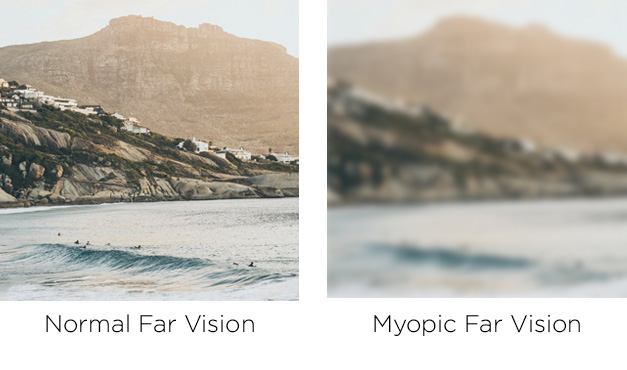What is myopia?
Myopia or short-sightedness means you can see things clearly up close, but for tasks that require distance vision, your eyesight becomes blurred. It is a very common cause of blurred vision where the eyeball is too long or the cornea has too much curvature (too steep), causing light entering the eye to focus in front of the retina instead of directly on it. A person with short sightedness might be able to see things up close quite clearly, like when they’re reading, depending on the degree of myopia. But for tasks that require distance vision, like driving or watching TV, their vision is blurred.
What causes myopia?
The causes are both genetic and environmental including:
Genetics play their part
There is a genetic component to myopia, so if there is a family history of nearsightedness, it is more likely to occur. Make sure you get your vision checked!
Increased use of technology
Compared to twenty years ago, children are interacting with more types of technology more often. Parents are happy to share their handheld devices with their children which are being used at ever closer distances. Children are using technology at a much younger age with lengthy screen times.
Perhaps the most easily avoided but biggest culprit is decreased outdoor time
When combined with access to technology, time spent playing outdoors has decreased. Various studies have concluded that time spent outdoors allows eyes to benefit from improved light and the ability to focus at distance.
Genetics play their part
There is a genetic component to myopia, so if there is a family history of nearsightedness, it is more likely to occur. Make sure you get your vision checked!
Increased use of technology
Compared to twenty years ago, children are interacting with more types of technology more often. Parents are happy to share their handheld devices with their children which are being used at ever closer distances. Children are using technology at a much younger age with lengthy screen times.
Perhaps the most easily avoided but biggest culprit is decreased outdoor time
When combined with access to technology, time spent playing outdoors has decreased. Various studies have concluded that time spent outdoors allows eyes to benefit from improved light and the ability to focus at distance.
What is progressive myopia?
This is a condition where myopia worsens over time, leading to increasingly severe levels of short-sightedness. This is characterized by a fast rate of myopic progression than what is considered normal. Individuals with progressive myopia may be at higher risk of developing further complications like retinal detachment, myopic macular degeneration or glaucoma.
Treatment for progressive myopia
Although there is no cure for myopia, the good news is that it can be managed if the advised corrective treatment from your Spec-Savers Optometrist is adhered to. It may mean that you need to wear glasses or contact lenses all the time. Adults may also have the option of laser eye surgery to correct their myopia.
Treatment methods for progressive myopia have come about due to an improved understanding of the condition and innovative optical advances in technologies.
These changes have been led by worldwide suppliers in an effort to reduce the prevalence of progressive myopia in the decades to come.
At Spec Savers, we strive to be at the forefront of optical advancements and our Optometrists have the necessary understanding needed to prescribe and treat progressive myopia using the current spectacle and contact lens technologies available from our partnered suppliers.
Myopia symptoms
It’s common for people with undiagnosed myopia to also experience symptoms like headaches or eyestrain when trying to focus on things far away.

How do I know if my child has myopia?
If your child has myopia, then they may complain about difficulty seeing into the distance, headaches, eye strain, and even fatigue.
Even if your child does not complain about their eyes or headaches specifically, there are other key signs you can look out for as a parent, including clumsiness, lack of concentration, eye rubbing, squinting, and falling behind with schoolwork or some developmental milestones.
At Spec Savers we are aware that this condition affects our most vulnerable customers, our children. Our optometrists - with our intelligent cloud-based software - are able to flag and monitor any diagnosed Progressive myope, therefore best placed to manage the sight and ocular care of our children cross our network
